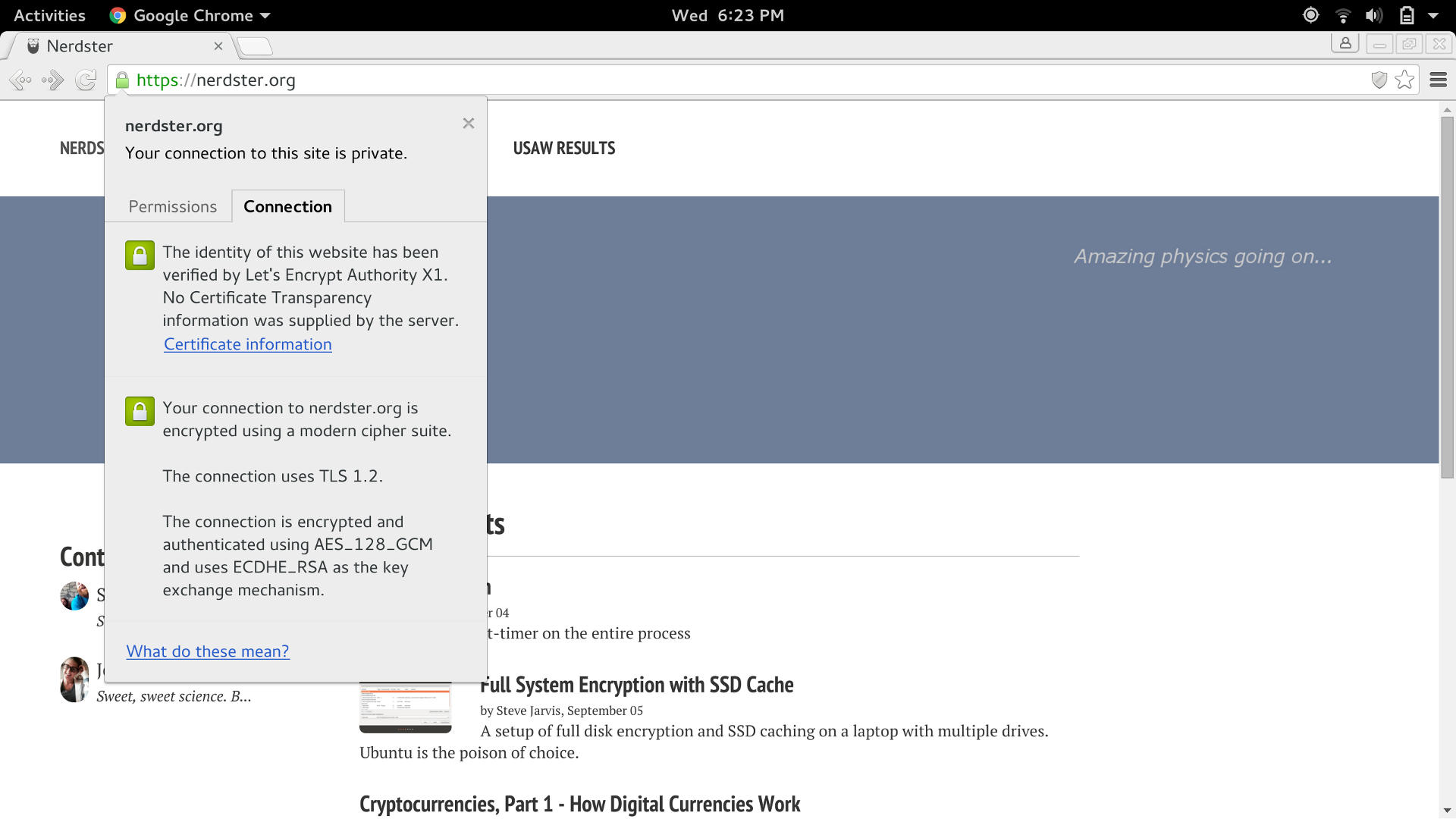This is largely for my own records, since I’m sure to move this again and/or break everything someday, but it’d be helpful for anyone heading down a similar path. Hours ago this site was hosted on GitHub Pages, which is awesome in its own right, but has its shortcomings. The biggest of which (for me) became the inability to offer SSL with a custom domain.1 I easily ignored this for a while, because I wasn’t willing to pay for a certificate to secure a simple blog, but now that Let’s Encrypt has come to save the privacy day, I’m inclined to make a move.
Long story short, the move was to get a VPS on Digital Ocean and run the site from there on Nginx. There are three general tasks to hit this goal:
- Install and configure Nginx over http.
- Get Jekyll auto-generating to the right place on new Git submissions.
- Get a cert from LetsEncrypt and direct all http traffic to https.
Where it matters, the solution will be specific to the Red Hat family (Fedora 23, specifically).

Nginx Setup
I’d only ever used Apache, but the talk of Nginx being “lightweight” was attractive, since I planned to get the cheapest Droplet Digital Ocean had to offer. The basic setup was exceedingly simple, and the only difference from the other tutorials I came across was the location of the config file. Likely due to the distro, but the config in question on Fedora is /etc/nginx/nginx.conf (not /etc/nginx/sites-available/). Simply change the root path to wherever the root of the site is planned to be.
Jekyll Auto-Generation
Digital Ocean’s own tutorial was very on the money here. I didn’t involve RVM, though, and I think that made dependency management a little more frustrating. Solving a “missing development tools” error thrown by gem ate up some time, and the missing package turned out to be something provided by rpm-build (“dnf install rpm-build ruby ruby-devel” should satisfy in the end). The necessary gems are “gem install jekyll jekyll-sitemap pygments.rb”.
In short, the idea is to use Git’s hooks to generate and publish the site at the end of each received push. The hook is just a bash script, and looks something like this:
#!/bin/bash -l
GIT_REPO=/home/git/nerdster.org.git
TMP_GIT_CLONE=$HOME/tmp/git/nerdster
PUBLIC_WWW=/usr/share/nginx/nerdster
git clone $GIT_REPO $TMP_GIT_CLONE
jekyll build --source $TMP_GIT_CLONE --destination $PUBLIC_WWW
rm -Rf $TMP_GIT_CLONE
exit
But unless I missed something, the linked tutorial skipped the issue of permissions. No user but root will be able to throw new files under nginx’s web directory. I solved this by creating a www-data group and adding the necessary users to it (me and git), as well as editing the ownership of /usr/share/nginx/nerdster to root:www-data. This also requires permission bits of 775 instead of 755.
Cert from Let’s Encrypt and Redirects
At the time of writing, most tutorials suggest that the letsencrypt client is pulled and built from source, but it’s already in Fedora’s default repos.2 Besides that simplification, Digital Ocean again proved to have a reliable set of steps to pull a certificate. Most of the linked tutorial isn’t necessary since letsencrypt is already in the repos, and the finer points are just to request a cert (after A records are as expected) and update Nginx to redirect port 80 traffic to port 443. The cert is initially requested by simply:
letsencrypt certonly --standalone
The standalone solution does start its own web server for communication and verification of the Internet address, so nginx must be stopped for a moment. Once that completes, the full certificate chain and private key are linked in /etc/letsencrypt/live/nerdster.org/[fullchain.pem|privkey.pem], respectively, and need to be added to the SSL section of the default nginx config (still /etc/nginx/nginx.conf). Here’s what the server sections of the current config look like (with a redirect from www to non-www, but minimally modified other than that):
# Redirect www to plain domain for consistency
server {
server_name www.nerdster.org;
# The $scheme variable would be the simple redirect, but no use
# redirecting again for SSL later if that's the case.
return 301 https://nerdster.org$request_uri;
}
# Make 80 redirect to 443/SSL
server {
listen 80;
server_name nerdster.org www.nerdster.org;
return 301 https://$host$request_uri;
}
# Settings for a TLS enabled server.
server {
listen 443 ssl;
listen [::]:443 ssl;
server_name nerdster.org www.nerdster.org;
root /usr/share/nginx/nerdster;
ssl_certificate "/etc/letsencrypt/live/nerdster.org/fullchain.pem";
ssl_certificate_key "/etc/letsencrypt/live/nerdster.org/privkey.pem";
ssl_session_cache shared:SSL:1m;
ssl_session_timeout 10m;
ssl_ciphers PROFILE=SYSTEM;
ssl_prefer_server_ciphers on;
# Load configuration files for the default server block.
include /etc/nginx/default.d/*.conf;
location / {
}
error_page 404 /404.html;
location = /40x.html {
}
error_page 500 502 503 504 /50x.html;
location = /50x.html {
}
}
C’est Fini
And that’s that, we got a sweet little green lock in the address bar. The site is auto-generated and republished every time a change is pushed to the repository and it’s all protected by TLS. The domains nerdster.org, http://nerdster.org, www.nerdster.org, and http://www.nerdster.org all redirect to https://nerdster.org.
-
I’m sure it will be possible soon, but not at time of writing. See this bug. ↩
-
Which is seriously impressive and a prime example of why I like Fedora. Let’s Encrypt entered public beta on December 3rd and was in the default repos by December 14th. Incredible. ↩
Leave a Comment